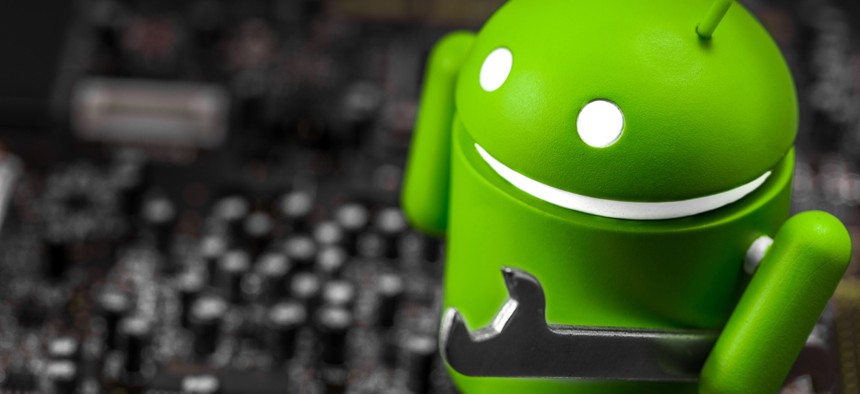Will Android Become the New Federal OS for Rugged Devices?

Primakov/Shutterstock.com
For the most part, the rugged devices I have evaluated over the years have had some flavor of Windows as their operating system.
It’s safe to say that government is one of the biggest deployers of rugged devices. At the federal level, the main users are military personnel operating in harsh environments, although other agencies also need more durable equipment than most of us carry around. For example, the Federal Emergency Management Agency deploys it for field workers and the Department of Agriculture equips some of its inspectors with rugged gear. It’s used a lot by state and local governments too, with plenty of rugged devices finding their way into the hands and vehicles of police and emergency responders.
The government even came up with its own method for evaluating rugged devices and other equipment, the MIL-STD-810 benchmark, which is currently in its tenth modification with MIL-STD-810H released last year. Because of its necessity in government, over the past 20 years, I have evaluated and reviewed hundreds of rugged devices looking to serve in that role. They came from many different companies including Dell, Panasonic, Itronix, General Dynamics, Getac and others. I have much of the equipment needed to test rugged gear in my lab, which I break out whenever I get a rugged review assignment.
For the most part, the rugged devices I have evaluated over the years have had some flavor of Windows as their operating system. So I was a little surprised when I was tasked with reviewing the new Panasonic Toughbook FZ-A3. It arrived at my lab last week and after a mandatory COVID-19 quarantine period, I unpacked it and got ready for the evaluation. Only when it booted up, it was running an Android operating system.
I have seen a few rugged phones over the years with different operating systems, but this was a full-size tablet, and one with the Panasonic Toughbook label, so the presence of a non-Windows OS was a little surprising. I reached out to Panasonic’s Joseph Valenti to see if this new development was part of an emerging trend. And according to him, Android is likely going to be a big part of the future when it comes to rugged devices in government, at least for tablets and non-notebook type devices and computers.
There are a few different factors driving this trend. The first is the fact that Microsoft is ending or has ended support for both Windows CE and Windows Mobile. Meanwhile, Apple has never successfully penetrated the government market. So Android is more or less the last OS standing.
But for rugged equipment, there are quite a few other factors driving the trend to Android in government, not the least of which is security.
“Android devices are very easy to lock down for government users,” Valenti said. “You can restrict them to just one or two functions, so a worker has everything they need to get their jobs done, but can’t do anything else that might expose an agency to unnecessary risk. So it becomes a very specialized tool.”
The Android OS can also help to streamline the setup process. Panasonic deploys what it calls a Productivity Plus Suite with its rugged Android devices. It allows the devices to be automatically provisioned, which can be done by the company or the agency. When a worker gets their new rugged tablet and boots it up the first time, it will automatically configure itself with exactly the tools they need and nothing more. You can even restrict which wireless networks the device is allowed to connect with for an extra measure of security. And in terms of the Toughbook FZ-A3, that includes being able to use the FirstNet network set up for emergency workers and first responders.
There are a few other advantages to using Android in a rugged device, like the ability for very careful monitoring of the tablet in a way that does not take up much processing power or resources. Using a centralized interface, administrators can see all kinds of interesting facts about the rugged tablets deployed at their agency. For example, they can see how many times a battery has discharged, how many times a device has been dropped or how many times it’s executed its configured functions.
The Android OS also makes devices a lot easier to use. Windows offers a lot of freedom but also complexity. Especially for a tablet that is locked down to certain functions, users only need to tap one or two buttons to do their job, as everything else is handled either automatically for them or in the background by administrators. To really push this point, the FZ-A3 runs on the Android 9 Pie operating system from 2018 and is restricted from upgrading. It doesn’t need the extra, mostly consumer-related functionality like chat bubbles offered by the latest versions of Android, and administrators don’t need to worry about a new OS breaking one of their legacy applications.
I have just started with the physical testing of the Toughbook FZ-A3, but so far it seems just as rugged and able to survive the MIL-SPEC testing as other devices in the line. Only the operating system is changed. And because of the additional security and management functions offered by Android over Windows, this is likely a trend that government users will soon start seeing throughout their agencies wherever rugged deployments are required.
John Breeden II is an award-winning journalist and reviewer with over 20 years of experience covering technology. He is the CEO of the Tech Writers Bureau, a group that creates technological thought leadership content for organizations of all sizes. Twitter: @LabGuys






